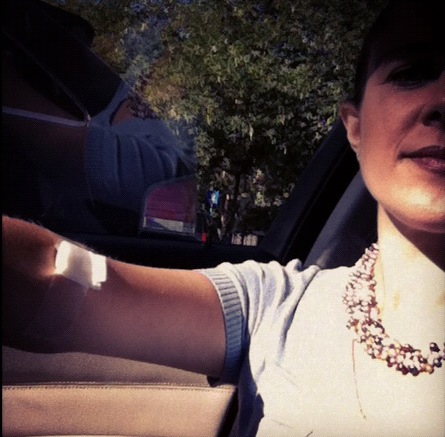I share in the book that I am on the kidney transplant list as well as some background as to how I landed myself there, but I wanted to lay out the specifics of exactly what that means in my case.
I was referred to my local transplant center in June of 2011. At the time my kidney function was 19%, stage 4 chronic kidney disease. That is the point at which you are eligible to apply for a transplant. You don’t actually need a transplant until you are below 15% kidney function, stage 5 (end-stage renal disease, kidney failure). Because there are over 95,000 people waiting for kidneys in the United States, the United Network of Organ Sharing let’s you join the list before you actually need the transplant so that you can begin accruing time on the wait list. Hopefully, when you need it, your name is toward the top of the list. The wait time where I live is currently 4 years.
I feel fortunate that my kidney disease is progressing at a slow enough rate that my family and I are able to be proactive about planning for when I am in renal failure, this includes finding a living donor which we are actively in the process of finalizing. We will have things lined up for when my body says that it is time for the transplant.
From June 2011 through June of 2012, my kidney was relatively stable. My doctors and I adjusted some medications which made processing medication waste products easier on my system and prolonged my function. Then came July, and now October…
In July my function dropped to 18%. This October it was 17%. For those of you who know lab values associated with chronic kidney disease, my creatinine is currently 3.13, too high. I blogged about that doctor’s appointment here.
At that same appointment, the doctors referred me to a class on living with chronic kidney disease to learn about dialysis. Dialysis is our backup plan. If my kidney transplant plans don’t pan out as expected, dialysis is option B.
Dialysis is intimidating. Lots of needles, access points, tubes, machines and time. Lots and lots of time. Depending on how you choose to do dialysis, you’re signing up for a commitment. Either 3 to 4 times a week for 3 or 4 hours at a time in a center, or at home for 2.5 hours 6 days per week for hemodialysis. Peritoneal dialysis “exchanges” are done 4 times each day.
Based on my surgical history, my doctors and I do not believe I am a candidate for peritoneal dialysis, too much scar tissue in my abdomen. That means hemodialysis, preferably at home, is our option B. That also means needles, lots and lots of needles.
Last night, Phillip asked me if I could stick myself with needles for dialysis. I think I could, it would definitely take some practice and getting used to, but I’m sure I’d get the hang of it. I asked him the same thing, and he too thought he would have no problem jabbing me with a needle.
To do hemodialysis, they create a “super vein,” okay, that’s just what I’m calling it. They sew a vein and artery together so that the vein grows larger to accommodate 2 needles per dialysis session, that’s 12 needles a week. You need a super vein because otherwise your vein would shut down and it would be hard to exchange blood through the dialysis machine. That was the most disturbing thing about this class, seeing the vascular access point. The vein gets HUGE. It sticks up way out of your arm, all twisty. The nurse even said that you can hear it if you put your ear up to it. If I had to have one, Phillip said that we’d just say I’d been working out a lot. Ha.
Here we are, sitting with 17% kidney function. Best guess is that I would need some sort of kidney replacement therapy (dialysis or transplant) when I reach 10% kidney function. It is around 10% that the doctors believe I would begin to have more dramatic symptoms. So we get our ducks in a row and wait until my body says it ready. I’ll be back at the doctor in January.

